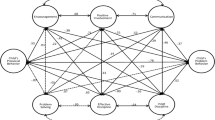Abstract
Thirty-three clinic-referred mother-child dyads were observed in their home settings and one of the home observations was videotaped. These pretreatment observations were analyzed to determine the degree to which mothers provided indiscriminate reactions to their children's prosocial/neutral and deviant responses. We suspected that these reaction tendencies were connected to maternal deficiencies in their monitoring of child behavior. To pursue this suspicion, monitoring performance was assessed by having the mothers watch their own videotaped home observations and, using their own definitions, code their children's positive and aversive responses. Professional observers then replicated this coding task. Results showed mothers and professionals to be in fair agreement in coding child positive responses, but in poor agreement coding the child aversive responses. Mothers tended to undercode these latter responses and to be highly inconsistent in their own coding. When measures of maternal coding bias were correlated with maternal indiscriminate child care reactions, the bias in coding child aversive responses proved to be associated, while the positive coding bias was not. Discussion of these findings was focused on maternal insensitivity as promoted by the mothers' conservative and ambiguous definitions of child deviance.
Similar content being viewed by others
References
Achenbach, T. M., & Edelbrock, C. S. (1981). Behavioral problems and problems and competences reported by parents of normal and disturbed chldren aged 4 through 6.Monographs of the Society for Research in Child Development, 46(1, Serial No. 188).
Brody, G. H., & Forehand, R. (1986). Maternal perceptions of child maladjustment as a function of the combined influence of child behavior and maternal depression.Journal of Consulting and Clinical Psychology, 54, 237–240.
Cerezo, A., Keesler, T. Y., Dunn, E. S., & Wahler, R. G. (1986).Standardized observation codes: Revision III-B. Unpublished document, Psychology Department, University of Tennessee, Knoxville.
Delfini, F., Bernai, M. E., & Rosen, P. M. (1976). Comparison of deviant and normal boys in home settings. In E. J. Mash, L. A. Hamerlynck, & L. L. Handy (Eds.),Behavior modification and families (pp. 203–219). New York: Brunner/Mazel.
Dumas, J. E., Gibson, J. A., & Albin, J. B. (1989). Behavioral correlates of maternal depressive symptomatology in conduct-disorder children.Journal of Consulting and Clinical Psychology, 57, 516–521.
Gardner, F. E. M. (1989). Inconsistent parenting: Is there evidence for a link with children's conduct problems?Journal of Abnormal Child Psychology, 17, 223–233.
Griest, D. L., Wells, K., & Forehand, R. (1979). An examination of predictors of maternal perception of maladjustment in clinic-referred children.Journal of Abnormal Psychology, 88, 277–281.
Holleran, P. A., Littman, D. C., Freund, R. D., & Schmaling, K. B. (1982). A signal detection approach to social perception: Identification of negative and positive behaviors by parents of normal and problem children.Journal of Abnormal Child Psychology, 10, 547–558.
Johnson, S. M., & Lobitz, G. K. (1974). The personal and marital adjustment of parents as related to observed child deviance and parenting behaviors.Journal of Abnormal Child Psychology, 2, 192–207.
Lorber, R., Reid, J. B., & Simard, K. (1979, December).Parent perception: Behavior tracking skills in distressed and nondistressed environments. Paper presented at the meeting of the Association for the Advancement of Behavior Therapy, San Francisco.
McCord, W., McCord, J., & Zola, I. K. (1959).Origins of crime. New York: Columbia University Press.
Panaccione, V. F., & Wahler, R. G. (1986). Child behavior, maternal depression and social coercion as factors in the quality of child care.Journal of Abnormal Child Psychology, 14, 263–278.
Patterson, G. R. (1976). The aggressive child: Victim and architect of a coercive system. In E. J. Mash, L. A. Hamerlynck, & L. C. Handy (Eds.),Behavior modification and families (pp. 32–50). New York: Brunner/Mazel.
Patterson, G. R. (1979). A performance theory for coercive family interaction. In R. B. Cairns (Ed.),The analyses of social interactions: Methods, issues and illustrations (pp. 178–202). Hillsdale, NJ: Erlbaum.
Patterson, G. R. (1982).Coercive family process. Eugene, OR: Castalia.
Reid, J. B., & Hendricks, A. F. (1973). A preliminary analysis of the effectiveness of direct home interventions for treatment of pre-delinquent boys who steal. In L. A. Hamerlynck, L. C. Handy, & E. Mash (Eds.),Behavior therapy: Methodology, concepts and practice, pp. 209–220. Champaign, IL: Research Press.
Robins, L. N. (1966).Deviant children grown up: A sociological and psychiatric study of sociopathic personality. Baltimore: Williams and Wilkins.
Rutter, M. (1975).Helping troubled children. Harmondsworth: Penguin.
Snyder, J. J. (1977). A reinforcement analysis of intervention in problem and nonproblem children.Journal of Abnormal Psychology, 86, 528–535.
Wahler, R. G. (1980). The insular mother: Her problems in parent-child treatment.Journal of Applied Behavior Analysis, 13, 207–219.
Wahler, R. G., & Dumas, J. E. (1986). Maintenance factors in coercive mother-child interactions: The compliance and predictability hypotheses.Journal of Applied Behavior Analysis, 13, 207–219.
Wahler, R. G., Williams, A. J., & Cerezo, A. (1989).The compliance and predictability hypotheses: Some sequential and correlational analysis of coercive mother-child interactions. Unpublished paper, University of Tennessee, Knoxville.
Author information
Authors and Affiliations
Additional information
This study was supported by research grant MH40227 from the National Institute of Mental Health.
Rights and permissions
About this article
Cite this article
Wahler, R.G., Sansbury, L.E. The monitoring skills of troubled mothers: Their problems in defining child deviance. J Abnorm Child Psychol 18, 577–589 (1990). https://doi.org/10.1007/BF00911109
Revised:
Issue Date:
DOI: https://doi.org/10.1007/BF00911109




